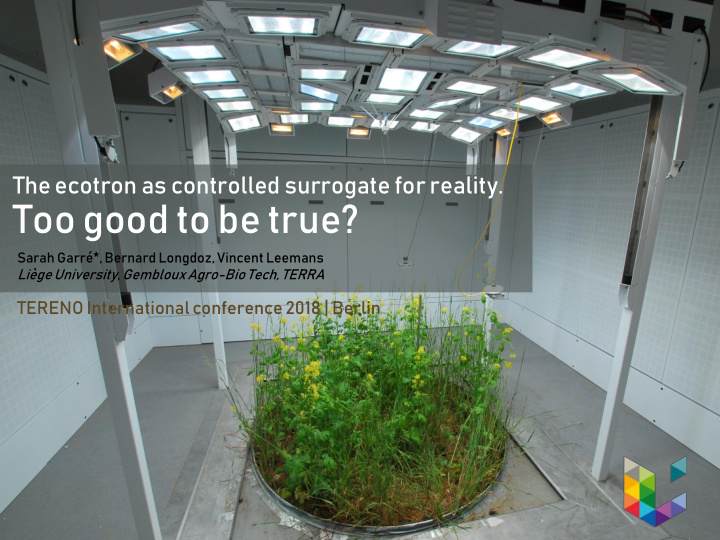



The ecotron as controlled surrogate for reality. Too good to be true? Sarah Garré*, Bernard Longdoz, Vincent Leemans Liège University, Gembloux Agro-Bio Tech, TERRA TERENO International conference 2018 | Berlin
Drawing graphic acknowledgements PhD
How adapt to climate change?
How can we preserve ecosystems and the services they deliver?
Ecotron Uhasselt, Belgium
Design new ecosystems?
SCALE GAP 8.5 cm
SCALE GAP 8.5 cm Intertwined processes
SCALE GAP MODELS? 8.5 cm Intertwined processes
SCALE GAP ECOTRON? 8.5 cm Intertwined processes
MODELS + Experimental Calibration Model improvement design Upscaling Downscaling
« An ECOTRON is a facility where ecosystems are confined in experimental chambers, allowing the simultaneous control of environmental conditions and the on-line monitoring of processes »
ECOTRON a tool to quantify the effect of current and future climate on our reality
Controlled atmosphere Plant: CO 2 , O 3 , T, RH, Rainfall Winter wheat Net flux of CO2, H2O, sensible Technical itinerary: heat (near future) 180 kgN/ha, 3 fractions Full light spectrum Reconstructed soil (at present) : 2m² x 1.5m intensity of max 1200 μ mole 2 horizons, 3m³, photons/m²/s cutanic Luvisol (colluvic) Soil T and h controlled Rainfall intensity min 0,2 l/min; max 7 l/min Sensors: Wind : T, WC, h, soil solution, total 0,1 et 0,3 m/s weight
Measurement of process & state variables High number of controlled variables Possibility to reach tipping points (resilience limits) by increasing a constraint
Experiment 0 Field 2015 Ecotron 2015 ICOS labelled site, Meteorological Lonzée BE conditions 2015 #3 Ecotron 2091 +2°C +50% CO 2 +300 PPM #3
Experiment 0 Field 2015 Ecotron 2015 ICOS labelled site, Meteorological Lonzée BE conditions 2015 #3 Ecotron 2091 +2°C +50% CO 2 +300 PPM #3
Experiment 0 Field 2015 Ecotron 2015 ICOS labelled site, Meteorological Lonzée BE conditions 2015 #3 0.1 Ecotron = surrogate reality? Ecotron 2091 +2°C +50% CO 2 +300 PPM #3
Experiment 0.1 Possible bottlenecks • Reproduction of wind and resulting turbulence • Thermal infra-red inputs from walls >< clear sky • Light intensity is limited to 1200 μ mole photons.m -2 .s -1 • Reconstructed soil (repacked horizons as in the field)
No wind Carlson et al. Simsphere Model work book
No radiative sky cooling DAY NIGHT
Intensity solar radiation Max ecotron = close to max photosynthesis
Repacked soil
Quantify impact of these bottlenecks with adapted models STICS | crop PASIM | pasture Coupled with ASPECT (atmosphere flux model) Impact soil structure: HYDRUS
Experiment 0 Field 2015 Ecotron 2015 ICOS labelled site, Meteorological Lonzée BE conditions 2015 #3 0.2 How does the Ecotron 2091 average future +2°C climate differ from +50% an average current CO 2 +300 PPM climate? #3
Experiment 0 Field 2015 Ecotron 2015 ICOS labelled site, Meteorological Lonzée BE conditions 2015 #3 Ecotron 2091 +2°C +50% CO 2 +300 PPM #3
Experiment 0.2 Ecotron 2015 Meteorological conditions 2015 Test ability of crop #3 models to predict crop growth under current and future climate Ecotron 2091 +2°C +50% CO 2 +300 PPM #3
Conclusion
Want to use the ecotron or its data? www.terra.uliege.be Pr. Bernard LONGDOZ Bernard.longdoz@uliege.be Vincent LEEMANS Vincent.Leemans@uliege.be
Thanks to the whole team preparing the first TERRA ecotron experiment Vincent Leemans Cathérine Ghymers Bernard Longdoz Bernard Heinesch Pierre Delaplace Benjamin Dumont JT Cornélis Gilles Colinet Sebastien Massart Bernard Bodson Julien Fouché Aurore Degré François Verheggen ….
Recommend
More recommend